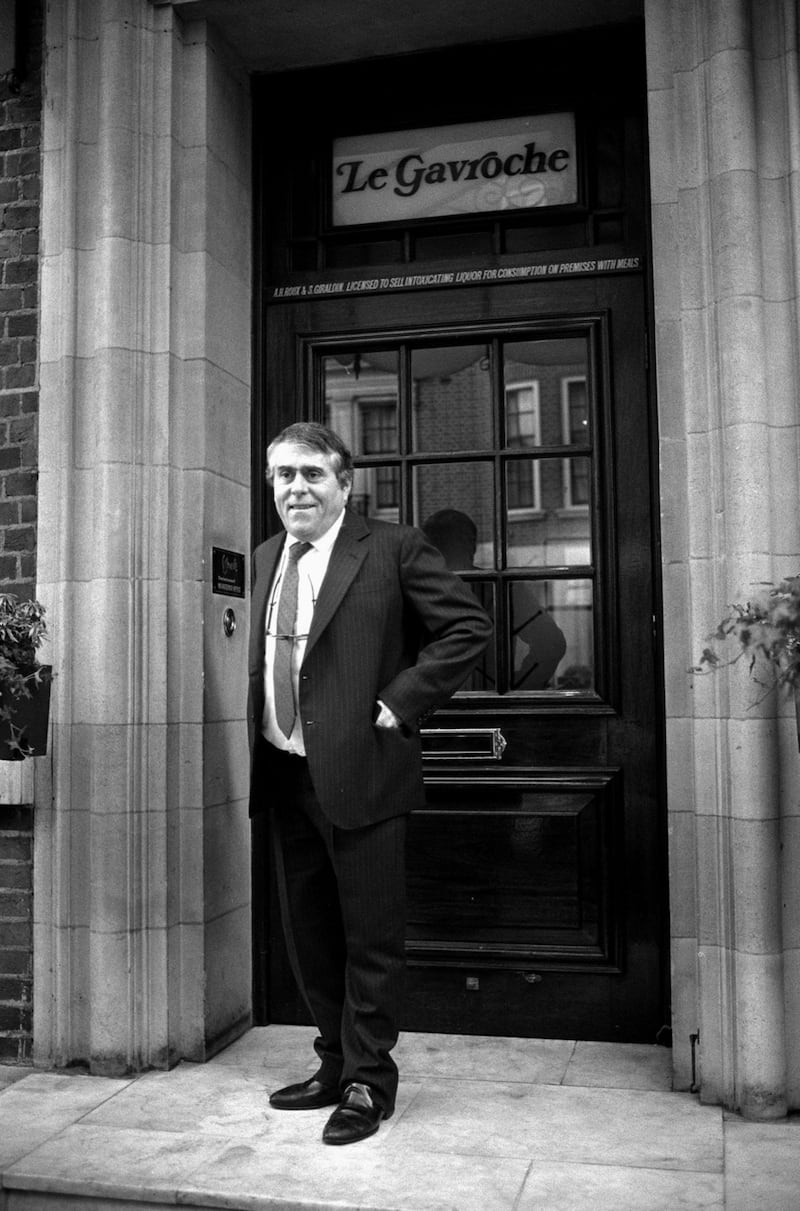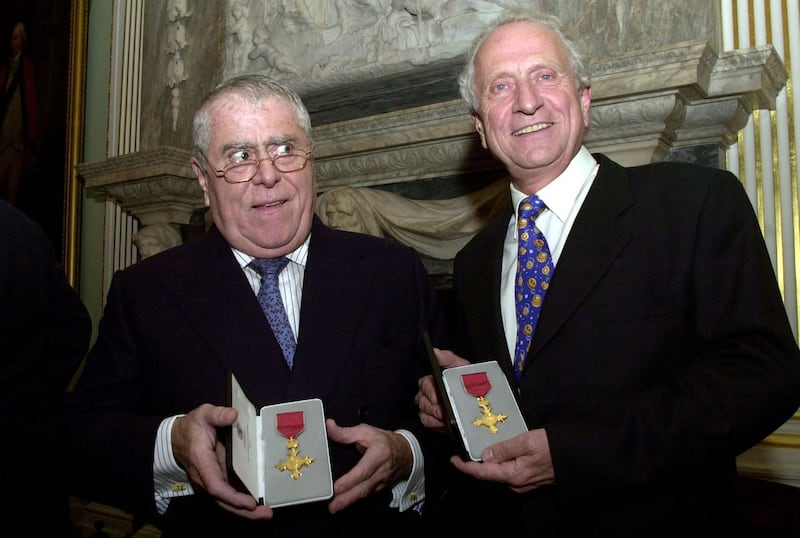Albert Henri Roux
Born: October 8th, 1935
Died: January 4th, 2021
At the time when Albert Roux opened the restaurant Le Gavroche in Lower Sloane Street, central London, in partnership with his younger brother, Michel, in 1967, the most innovative kitchens in Britain were often run by amateur cooks from other walks of life, who lacked that rigorous youthful apprenticeship and hard graft that was the presumed career path of any haute cuisine chef worth his (rarely her) salt.
Beyond the grandest hotels, which still followed the precepts of Escoffier and other French masters, British restaurants paid homage to a cookery – still most often French – that was both more domestic and more relaxed. They were awful.
Le Gavroche operated on a different plane and set standards of thoroughgoing classic French cooking that had not been seen for many years. It acted as training ground and spearhead of a revival of serious (and expensive) French restoration that spread through the capital and beyond.
Albert, who has died aged 85, was not merely a chef, he was also a businessman of energy and acuity. The brothers soon had a handful of restaurants, a charcuterie and a butcher’s shop under their direct control, as well as setting up former members of staff in places of their own, pioneering vacuum-packed sous-vide dishes for the restaurant trade, undertaking contract and outside catering, and acting as consultants. Their enterprise was one of the foundation stones of modern British food culture.

Born in Semur-en-Brionnais, a village in southern Burgundy, Albert was the eldest son, and second child, of Henri Roux, a third-generation charcutier, and his wife, Germaine (nee Triger). After the second world war the family moved to St Mandé, a suburb to the east of Paris. Albert began his career, after training as a pâtissier – though he originally harboured thoughts of the priesthood – as private chef to wealthy Britons (save a stint at the French embassy in London and two years at the British embassy in Paris).
He did not cook in a commercial kitchen until the age of 32. His first job, described as “scullery boy” on his work permit, was with Nancy Astor, Viscountess Astor, at Cliveden in Buckinghamshire. His longest engagement was with Major Peter Cazalet, racehorse trainer to the Queen Mother, among others, at his Fairlawne estate in Kent. After eight years he nursed an ambition to start his own restaurant, in partnership with Michel – though he retained an abiding love of racing (as well as being a keen fisherman).
Le Gavroche (meaning “street urchin”) opened to a glittering launch party: Rolls-Royces were double-parked. The interior was the work of the society designer David Mlinaric; on the walls hung borrowed paintings by Chagall, Miró and Dalí – all signs that this new place had the poshest of patronage. The original backers came from Cazalet’s friends and City acquaintances, as well as corporate input from International Distillers.
All the tropes of haute cuisine were on show: mousses, forcemeats, reductions, emulsions and complex sauces and, most particularly, ingredients and raw materials esteemed by the French.
This meant at first that Albert’s wife, Monique (whom he had married in 1959), was dispatched across the Channel to smuggle back foie gras, poulets de Bresse and Challans duck, then unobtainable in Britain. This was to be the impetus for the brothers arranging a constant supply line from the Rungis vegetable market in Paris, which resulted eventually in a large business provisioning restaurants throughout London.
Although there may have seemed an emphasis on elaborate and fanciful dishes, Albert also nursed an affection for the standbys of French cuisine bourgeoise: his Pot au Feu Sauce Albert, which figured on the very first menu, was a case in point.
Wealthy high-living diners may have made a beeline for the restaurant, but it did not immediately meet with universal approval. Reporters to the Good Food Guide (which infuses its gastronomy with a certain flavour of the British middle classes) found its prices too high, its resolute embrace of the rich and famous disconcerting and its waiting staff impossible. It was even dropped entirely from the 1970 edition.

However, the thoroughness of the brothers’ approach, and the skills on display in their kitchen, ensured its ultimate acceptance, with a single star awarded by Michelin’s first British edition in 1974, then the ultimate three-star accolade the year after the restaurant moved to new premises in Upper Brook Street, Mayfair, in 1981.
Albert’s enthusiasm for business, while he still found the time to remain a chef of accuracy and finesse, was remarkable. In this he differed from Michel, who preferred to concentrate on a single defining project. In a few years, the enterprise had expanded in many directions.
There were satellite restaurants: the Poulbot (also meaning urchin), the Brasserie Benoît (later Le Gamin), the Waterside Inn on the Thames at Bray (which came to be Michel’s particular responsibility), Gavvers (on the old Gavroche site), Rouxl Britannia (which offered sous-vide dishes from a central kitchen, with no chef in evidence) and Les Trois Plats.
Then there were shops: the charcuterie Le Cochon Rose (run by Albert’s elder sister, Liliane), and the Boucherie Lamartine in Ebury Street. The brothers organised contract catering, created a central pâtisserie and ran a restaurant supply business. Finally, they set up a boutique hotel in Park Street, close to the new Gavroche.
In 1986 they agreed to separate their business interests, Albert remaining at the helm of many of these subsidiary activities. Some of these were eventually sold to the Compass Group in 1993, with Albert as consultant. Others were sold or closed during the 1990s.
The Roux brothers’ restaurants were also an important seminary for young chefs, at first French but latterly British, who went on to make their mark at home and abroad, among them Pierre Koffmann, Christian Germain, Jean-Louis Tabaillaud, René Bajard, Christian Delteil, Rowley Leigh, Gordon Ramsay, Steven Doherty, Peter Chandler, Marcus Wareing and Marco Pierre White.
It was estimated that more than half of Britain’s Michelin-starred restaurants in 2013 were run by Roux seminarians. This educational role was broadened by the Roux scholarship scheme, started in 1984, as well as Albert’s long involvement with many colleges. His star pupil of course was his son, Michel Roux Jr, to whom he ceded control of Le Gavroche in 1991.
Albert’s later years were devoted especially to consultancy work with the Compass Group and others, giving rise to a number of Roux restaurants in London, Scotland (for which he had an affection, due to his love of fishing in the Highlands and Islands) and abroad (not forgetting his British restaurant, Berties, in Paris).
In the 1980s Albert appeared on the pioneering television cookery programme Take Six Chefs. This was followed by the series At Home with the Roux Brothers on the BBC in 1987, which brought them unexpected TV popularity.
While instructing home cooks how to prepare proper stocks, or how best to use a litre of cream for their soufflés suissesses, they engaged in strongly French-accented banter worthy of a comedy act, sharpened by their not being at the time on the best of terms, and heightened by the contrast in their respective physiques: Michel slender and elegant, Albert the short and bustling one. The recipe book that accompanied the series, together with their earlier New Classic Cuisine (1983), is a valuable record.
Albert was made OBE in 2002 and a chevalier of the Légion d’Honneur in 2005. He took British citizenship in 2015. His marriage to Monique ended in divorce in 2001; his second marriage, to Cheryl Smith in 2006, ended in divorce in 2016.
He married again, to Maria Rodrigues, and is survived by his children from his first marriage, Michel Jr and Danielle. – Guardian









